

USKids History: Book of the American Colonies (Brown Paper School): Howard Egger-Bovet, Marlene Smith-Baranzini, D.J. Simison: 9780316222013: Amazon.com: Books. Leif Eriksson (On My Own Biographies): Shannon Knudsen, Mark Oldroyd: 9781575058283: Amazon.com: Books. European Exploration: The Age of Discovery. Christopher Columbus: What Really Happened. Taino_frame. 10 Things You May Not Know About Christopher Columbus - Reading for the Columbus Puzzlement. Must change one sentence in #4!!!! Inapproproate word. On October 12, 1492, Christopher Columbus set foot on the fine white sands of an island in the Bahamas, unfurled the Spanish royal standard and claimed the territory for King Ferdinand and Queen Isabella.
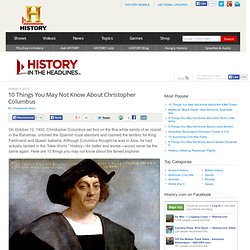
Although Columbus thought he was in Asia, he had actually landed in the “New World.” History—for better and worse—would never be the same again. Here are 10 things you may not know about the famed explorer. 1. Columbus didn’t set out to prove the earth was round. 2. 3. 4. 5. 6. 7. History, Travel, Arts, Science, People, Places - click on CONTINUE TO THE SITE. CHRISTOPHER COLUMBUS - full movie - EN. What Was It Like? Milk Carton Spanish Galleon Craft. Materials: 2 milk cartons 2 straws playdough black and white paper (construction paper) glue, scissors and tape Optional: template pieces (see bottom of this page) -- you could also make them yourself with white paper and markers.
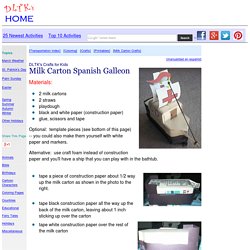
Alternative: use craft foam instead of construction paper and you'll have a ship that you can play with in the bathtub. Theageofdiscovery - Navigational Instruments. In this page you are going to see the navigational intruments they used as well as when and how they used them.Compasses, astrolabes and maps from the previous explorers were used in the first voyage to America.they also used portulan charts, sandglasses, hourglasses and cross staffs.The cross staff consisted of a long staff with a perpendicular vane which slides back and forth upon it.
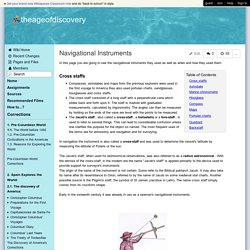
Columbus' Mutinous Crew Video - Columbus Controversy. Exclusive: Found after 500 years, the wreck of Christopher Columbus’s flagship the Santa Maria - Archaeology - Science. “All the geographical, underwater topography and archaeological evidence strongly suggests that this wreck is Columbus’ famous flagship, the Santa Maria,” said the leader of a recent reconnaissance expedition to the site, one of America’s top underwater archaeological investigators, Barry Clifford.

“The Haitian government has been extremely helpful – and we now need to continue working with them to carry out a detailed archaeological excavation of the wreck,” he said. So far, Mr Clifford’s team has carried out purely non-invasive survey work at the site – measuring and photographing it. Tentatively identifying the wreck as the Santa Maria has been made possible by quite separate discoveries made by other archaeologists in 2003 suggesting the probable location of Columbus’ fort relatively nearby. Columbus' Modern Ships Video - Christopher Columbus. Christopher Columbus Ships. Christopher Columbus had three ships on his first voyage, the Niña, the Pinta, and the Santa Maria.
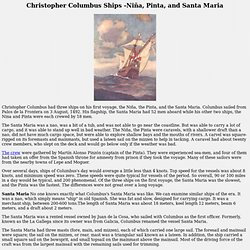
Columbus sailed from Palos de la Frontera on 3 August, 1492. His flagship, the Santa Maria had 52 men aboard while his other two ships, the Nina and Pinta were each crewed by 18 men. The Santa Maria was a nao, was a bit of a tub, and was not able to go near the coastline. But was able to carry a lot of cargo, and it was able to stand up well in bad weather. Athena Review 1,3: First Voyage of Columbus. Free trial issue subscribe back issues Athena Review Vol. 1, no.3.

Christopher Columbus Ships. The Pinta means the "Painted One" and was probably a nickname given to the ship.
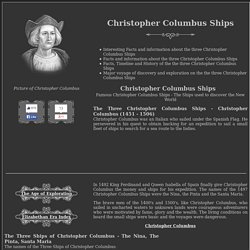
The Nina means "Girl" but was originally called the Santa Clara. Her nickname 'Nina' probably derives from her master, Juan Niño. History - Ancient History in depth: Viking Quest. Primary History - Vikings - Who were they? Vikings Homework for kids. Primary History - Vikings. Viking Exploration Video - Vikings. Season five begins with Ivar the Boneless asserting his leadership over the Great Heathen Army, while Lagertha reigns as Queen of Kattegat.
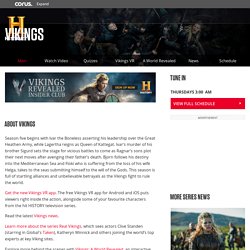
Ivar’s murder of his brother Sigurd sets the stage for vicious battles to come as Ragnar’s sons plot their next moves after avenging their father’s death. L'Anse aux Meadows Viking Settlement Info. L'Anse aux Meadows is the name of an archaeological site that represents a failed Viking colony of Norse adventurers from Iceland, located in Newfoundland, Canada and occupied for somewhere between three and ten years.
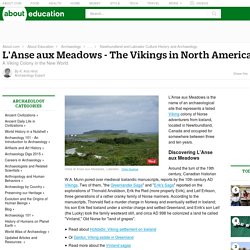
Discovering L'Anse aux Meadows Around the turn of the 19th century, Canadian historian W.A. Munn pored over medieval Icelandic manuscripts, reports by the 10th century AD Vikings. Two of them, "the Greenlander Saga" and "Erik's Saga" reported on the explorations of Thorvald Arvaldson, Erik the Red (more properly Eirik), and Leif Erikson, three generations of a rather cranky family of Norse mariners. According to the manuscripts, Thorvald fled a murder charge in Norway and eventually settled in Iceland; his son Erik fled Iceland under a similar charge and settled Greenland; and Eirik's son Leif (the Lucky) took the family westward still, and circa AD 998 he colonized a land he called "Vinland," Old Norse for "land of grapes".
Vinland - Identifying the Viking Homeland in America. In the 1960s, archaeologists Helge and Anne Stine Ingstad used the medieval Vinland Sagas to search for evidence of Viking landings on the North American continent.
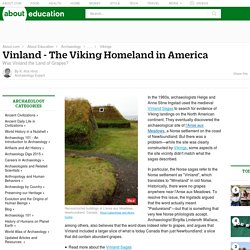
They eventually discovered the archaeological site of l'Anse aux Meadows, a Norse settlement on the coast of Newfoundland. But there was a problem—while the site was clearly constructed by Vikings, some aspects of the site vicinity didn't match what the sagas described. In particular, the Norse sagas refer to the Norse settlement as "Vinland", which translates to "Wineland" in old Norse.
Historically, there were no grapes anywhere near l'Anse aux Meadows. To resolve this issue, the Ingstads argued that the word actually meant "Pastureland"—but that is something that very few Norse philologists accept.